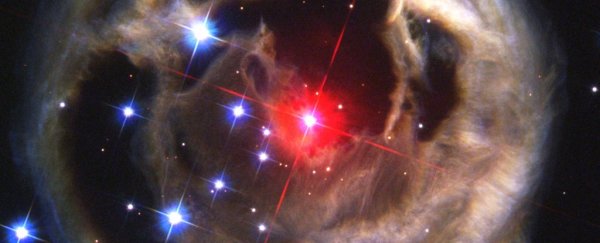Well, this sure is one parade that's getting rained out of existence. A spectacular astronomical event that had been predicted for 2022 now isn't going to happen after all.
Early in 2017, scientists forecast the collision of two stars in the constellation Cygnus – something that would result in a rare and wonderful phenomenon visible to the naked eye. And the news spread like wildfire.
The two stars, located a mere 1,800 light-years from Earth, are currently locked in a spiralling death dance. According to the researchers, in the year 2022 – just a few short years away – they were going to collide.
And it wasn't just going to be a small blip in the night sky. When binary star system KIC 9832227 finally merged, it was going to produce a luminous red nova - increasing in brightness 10,000-fold, which would be visible from Earth for some time.
Now, though, that prediction has been nixed.
*Sad trombone*
A team of researchers led by astronomer Quentin Socia at San Diego State University has meticulously pored over the mathematics, and come up with a different result.
And the original researcher - astronomer Larry Molnar from Calvin College - has agreed with this new finding.
"Good science makes testable predictions," Molnar said.
"There have been a few other papers that have tried to poke at our project, and we've been able to poke back - criticisms that just don't fly. But this one does fly, and I think they have a good point. This illustrates how science can be self-correcting."
The problem was found to be with the data Molnar and his team used to make the prediction.
KIC 9832227 is a fascinating system. The two stars are locked in with each other so tightly that they take just 11 hours to perform one full orbit. And they're so close that they actually share parts of their atmospheres, what is known as a contact binary.
They're also an eclipsing binary, oriented in just the right way that, as they orbit, they eclipse each other from our point of view here on Earth.
The prediction was based on the timings of minimum light – that is, the point at mid-eclipse in which the light from the binary system is at its lowest – from all available sources.
Molnar and his team used Calvin Observatory data between 2013 and 2016. Between 2007 and 2013, they used data from other observatories. There was a long gap in the data before 2007, but in 1999, one observation had been taken as part of the Northern Sky Variability Survey.
Socia and his team got their hands on previously unpublished archival data from 2003, taken as part of the NASA Ames Vulcan Project. And they found that the eclipses were occurring half an hour later than predicted by Molnar's merger hypothesis.
They re-ran the numbers, and the timings after 2007 checked out. But that one 1999 datapoint was awry - a full hour later than it was supposed to be.
The culprit? A typo.
Yep. In the paper that originally described the 1999 data, published in 2004, a typo resulted in the misrepresentation of the timing of the eclipse by 12 hours. This error was carried into Molnar's team's calculations.
Interestingly, the typo didn't occur in the article's preprint (it's the mjd, or Modified Julian Date, value in Table 6).
The eclipse absolutely couldn't have occurred at the time the published paper stated, either. Socia calculated where KIC 9832227 would have been at that specific time. It would have been below the horizon. The telescope would not have been been able to see it.
This isn't to say that, at some point in the future, KIC 9832227 isn't going to go kaboom; but that point isn't going to be in 2022.
And yes, we're a bit deflated about it; but ultimately, while science can giveth, its ability to taketh away is equally important.
"This is arguably the most important part of the scientific process. Knowledge advances the most when bold predictions are made, and people question and test those predictions," Socia said.
"Often the most exciting discoveries happen when our expectations are not met. This is a good example of how scientists from different parts of the world can work together to better understand how our universe works, bringing with them new pieces to the puzzle."
So it's not going to be KIC 9832227. But eventually a binary star is going to collide, and there are now a lot of eyes out there looking for it.
"The authors of the manuscript don't question our fundamental premise, which is to say 'this is something that you should be looking for, this is something that can be found,'" Molnar said.
"It's actually because they agree with that fundamental premise that they dug deeper. And so the search for an impending stellar merger continues."
The research has been published in The Astrophysical Journal Letters.
